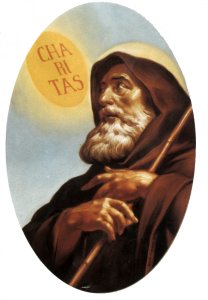
Francis was born in Paula (Cosenza) on March 27, 1416, to Giacomo Martolilla and Vienna from Fuscaldo. Being advanced in years, his parents attributed the birth of their eldest child to the intercession of St Francis of Assisi. This is the reason why they named him Francis and promised to make him wear the votive habit of Franciscans for a year At the age of fifteen Francis went to the monastery of the Friars Minor Conventuals in St Marco Argentano (Cosenza) to fulfil the vow made by his parents. Here Francis showed his disposition to prayer and his devotion, along with those supernatural powers which made him famous as a wonder-worker afterwards. The friars wished that he kept on living with them but, when the year to spend in St Marco Argentano passed, Francis, feeling that the time of a radical choice of life was approaching and wishing to know the several kinds of religious life-styles, left the monastery and went on a pilgrimage to Assisi with his parents. On his way to Assisi he visited Rome. He was troubled deeply by what he saw in Rome. According to his anonymous first biographer, Francis rebuked a cardinal because of his luxurious clothes with these words, "Our Lord did not dress like that". This episode shows that the young-man was maturing the idea of an ecclesiastical life-style based on poverty.
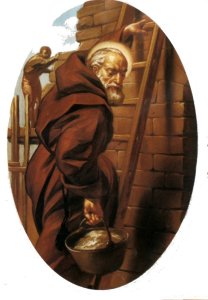
Soon, a lot of people, wishing to follow Francis and share his severe life-style, joined him. When Mgr. Pirro Caracciolo, appointed Archbishop of Cosenza on August 31, 1452, reached his diocese, the movement obtained his approval and was allowed to build a chapel. The streams of pilgrims who went to Paula drew Paul II’s attention. As a consequence, the Pope sent one of his Apostolic Visitors, Mgr. Baldassarre De Gutrossis, to Paola at the beginning of 1467 to make him inquire into Francis’s life. On his coming back to Rome the Visitor reassured the Pope about Francis’s loyalty to the Apostolic See. Furthermore, since the Hermit started to build a church in Paula on July 7, 1467, the Visitor persuaded four cardinals to grant indulgence, under the usual conditions, to the pilgrims who visited the church or contributed financially to its building.
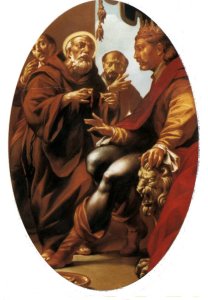
Francis became a religious and social guide in Paola by conquering the hearts of the people who went to him to talk about different kinds of questions. Furthermore, the Hermit was seen as the only bulwark against the abuses of the Aragonese court and as a man who was able to support simple and poor people by speaking on their behalf as a real "humanist" could do. Because of his life-style, Francis was a protester who reminded of the great ascetics. He was approached by the poor as well as by the rich, yet he was regardless of their social rank. A witness told that Galeazzo of Tarsia, Baron of Belmonte, went to Paola many times to beg for his healing and that Francis made him carry stones with some workmen. The Saint could inspire people to a deep devotion and faith by exhorting them to pray and do God’s will.
From the very beginning Francis was a famous wonder-worker. He worked wonders for all of his life, from the building of his first monastery till his French period. His powers were on behalf of the poor and of people who were oppressed by the frequent embezzlements, against which Francis spoke indefatigably, of the powerful. He used common objects to work miracles so that everyone understood that it was God who really restored people to health or solved problems. The following episode is a good example of his "wonder methodology": a young-man of Paula had a wound in his arm which could not heal although he had consulted famous doctors. ‘Go to Francis and he will heal you’, his mother said to him. He made up his mind and went to the Saint to tell him about his problem and his unsuccessful attempts to solve it. Francis stooped down to pick a herb at random and said, ‘Make it boil, put it on your arm and you will heal’. The young-man looked at him and objected, ‘This is common herb, how can it work miracles?’. ‘It is the faith which works miracles’, the Hermit replied. Again, when a priest said to Francis, ‘How do you know that this herb has healing virtues?’, the saint answered, ‘To whom is a faithful servant of God and obeys his commandments even herbs reveal their virtues’. One day Francis crossed the Straits of Messina by standing on his cloak laid on water. This well-known episode and other miracles often inspired men of letters and artists who immortalized them with their works of art.
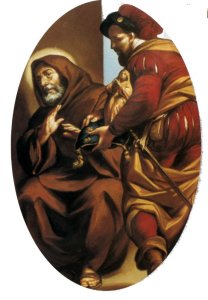
Thanks to Neapolitan merchants Francis’s fame reached the court of the French king Louis XI. Since the king was very ill at that time, he asked Pope Sistus IV to send the hermit to his death-bed. This was the beginning of the "diplomatic chapter" of Francis’s life. The Pope, wishing to sign a treaty with France in order to abolish the Pragmatic Sanction of Bourges (1438), granted Louis XI’s request willingly and so did the King of Naples. Despite this it took months to persuade Francis to leave. He went to France only when the Pope ordered him to do it. He found it hard to obey because he was old (67), busy with the recent spread of his order to Sicily and unwilling to live in a royal palace after a life as a hermit. However, later on Francis was amply rewarded for his sacrifice of leaving the Kingdom of Naples by the favour that the French court granted, also by influencing the Roman Curia, to his order..
After leaving the hermitage of Paterno on February 2, 1483, Francis was triumphally welcomed in Naples by common people as well as by King Ferdinand I, who, fearing a French invasion, hoped that Francis could prevent it by going to France. The king expected in vain to get a preferential treatment from Francis. Pope Sistus IV received the Hermit in Rome more than once and entrusted him with important tasks. When Francis reached Louis XI’s castle at Plessis-les-Tours the king bowed to him and begged him for a blessing. Although the king could not heal, Francis contributed to a long period of friendly relations between the Papacy and the French monarchy. This was a benefit also to the kingdoms of Spain, Bohemia and Naples.
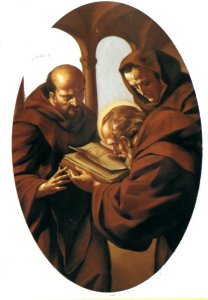
Francis endeared himself to the French court and, although he could not speak French, he was approached by common people hoping for his miracles as well as by Sorbonne graduates wishing to mend their ways. Francis lived in France for about twenty-five years. There he led a simple life, for instance he used to work a piece of land, and was seen as reformer of religious life-style, as a penitent and eremitic saint, as a second John the Baptist. Because of his austere life-style he was chosen as a spiritual guide by some Benedictines, Franciscans and hermits, who left their religious orders to follow him. This made his Calabrian congregation international and changed it deeply, since the eremitic life-style was substituted for the coenobitic one. This change led to the foundation of the Order of Minims, then to that of the secular Third Order and finally to that of the Cloistered Nuns. Their Rules were definitively approved by Pope Julius II on July 28, 1506.
Francis died in Tours on April 2, 1507. The fame of this wonder-worker spread through Europe thanks to the three branches of his order (friars, nuns and third order) and contributed to his beatification (July 7, 1513) and his canonization (May 1, 1519), which took place after only twelve years since his death.
People were fond of Francis, who became patron of several kingdoms. The number of churches which were built in his honour increased. People turned to him in a familiar way and kept souvenirs of him as precious relics (in Paola, in 1510, that is, even before his beatification, it was common that people touched or put on his clothes). He was declared patron saint of Italian seamen by Pope Pious XII on March 27, 1943, and of several kingdoms like France, Spain, Naples and Bohemia. He is particularly invoked by childless couples. People who emigrated from southern Italy - Francis was declared patron saint of Calabria by Pope John XXIII in 1963 – and the conquests of the Spanish Kingdom amply contributed to increase devotion to him and spread some religious practices he had suggested. He is one of the best-known Christian saints and a lot of people are named after him.
There are a lot of icons of Francis. The best-known portrait of him, which inspired a lot of painters, is by Jean Bourdichon. It is worth noting that even before his canonization (1519), on his sepulchre there was "the life-sized portrait of the saint, who was meagre, white- and long-bearded, and with a serious face which inspires holiness". After the Council of Trent painters emphasized the supernatural powers of the Saint, similarly to what hagiographers did.
From a liturgical point of view St. Francis’s Day falls on April 2.
For more information:
Bibliography: Francesco Russo, Bibliografia di S. Francesco di Paola, 2 voll., Roma 1957 e 1967.
Sources: I Codici autografi dei processi casentino e turonense per la canonizzazione di S. Francesco di Paola (151 –1513), Roma 1964; Vita S. Francisci de Paula, Minimorum Ordinis institutoris, scripta ab anonimo eiusque sancti discipulo eique coaevo, a cura di Giuseppe Perrimezzi, Roma 1707 (rist. Paola 1967).
Biography: Giuseppe Roberti, S. Francesco di Paola fondatore del Ordine dei Minimi (1416-1507). Storia della sua vita, Roma 19632; S. Francesco di Paola, Chiesa e società del suo tempo. Atti del convegno Internazionale di studio (Paola 20 – 24 maggio 1983), Roma 1984 (Bibliotheca Minima 1); Pietro Addante, San Francesco di Paola, Cinisello Balsamo 1988.
Order: Alessandro Galuzzi, Origine dell’Ordine dei Minimi, Roma 1967; Giuseppe Fiorini Morosini, Il carisma penitenziale di S. Francesco di Paola e dell’Ordine dei Minimi. Storia e spiritualità, Roma 2000 (Bibliotheca Minima 3).
Rule: Redazioni della regola e correttorio dei Minimi. Testo latino e versione italiana, a cura di Antonio Castiglione, Roma 1978.
Devotion: Fede, Pietà, Religiosità popolare e S. Francesco di Paola. Atti del II convegno Internazionale di Studio (Paola, 7-9 dicembre 1990), Roma 1992 (Bibliotheca Minima 2).
Iconography: Robert Fiot, Jean Bourdichon et Saint François de Paule, Tours 1961.
Copyright 2007